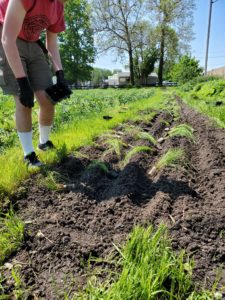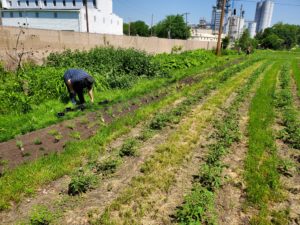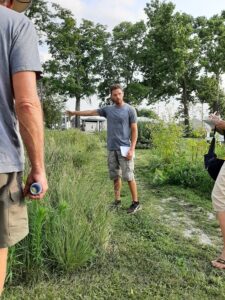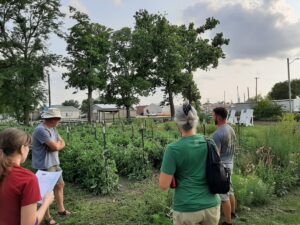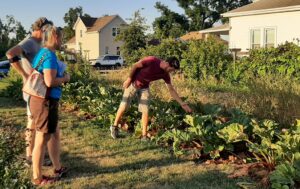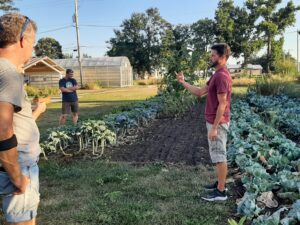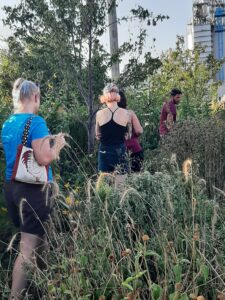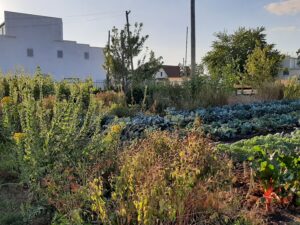Final report for FNC20-1215
Project Information
Matthew 25's Cultivate Hope Urban Farm is a 3-acre urban vegetable farm. We do a small CSA and farmer's market as well as providing produce for Matthew 25's Groundswell Cafe and food pantry site. We grow a wide variety of vegetables, fruits and herbs using organic and restorative practices. Our integrated pest management strategy is free of chemical sprays and toxins. We are working to become no-till and believe that healthy soil equals healthy plants. We cover crop extensively, plant native flowers to attract native pollinators and beneficial insects, practice long crop rotations and understand that we are striving to create a functioning food producing ecosystem with many coexisting organisms. We seek to create a balance between all these moving pieces.
For organic vegetable farmers, pest management can often be the most challenging and pressing issue. Even pesticides that are certified organic are often broad spectrum and end up destroying beneficial and pollinating insects and contaminating soil and water. The continued use of these chemicals also leads to the development of resistance among the targeted pests, leading to increased use of the chemical or the creation of ever more powerful substances that cause more contamination. Used in conjunction with other methods of an overall integrated pest management system, beetle banks can provide a significant boost in the control of crop pests and weeds by providing habitat for native ground beetles that forage among the crop growing areas for pests and weed seeds. Beetle banks that are planted with native grasses and wildflowers also serve to provide habitat for a wide array of native species of beetles and pollinating insects. They also help to prevent soil erosion by having roots in the ground at all times of the year. The effects on pest and weed control can save labor costs by freeing up the farmer’s time that would otherwise be spent controlling pests and weeds by more intensive methods.
- Install two beetle banks with the help of high school students participating in our job training program.
- Use the beetle banks throughout the season as a learning tool for students. The beetle banks will be a continuous learning tool throughout the duration of the grant and beyond, as students help to maintain them and participate in workshops and demonstrations.
- Provide workshops for community gardeners and local farmers on the benefits of beetle banks as a tool of organic pest management, using the beetle banks as a demonstration and education site.
Cooperators
Research
The beetle banks will be used mainly as a hands-on continuous learning project for students and community gardeners that Matthew 25 works with. Students involved in our high school job training program will play a direct role in every stage of the beetle banks.
They will help with the design of the banks by working with the project coordinator to plan the layout and location of the banks, what will be planted on the banks, and a schedule for routine maintenance and care of the banks. The students will also help with the installation of the beetle banks, helping with the project coordination and getting hands-on experience in building and planting the banks. This entire process will be used as a way to educate the students on the ideas and methods of organic integrated pest management on a vegetable farm. The students will also be involved in the maintenance of the beetle banks, by helping with weeding and any additional planting and seeding throughout the season and getting them to a point of establishment. Community gardeners and local farmers will be invited to participate in two workshops throughout the length of the grant, where they can see the newly constructed beetle bank and learn about the benefits of their incorporation into an integrated pest management strategy. The project coordinator will be the leader and main educator of the workshops, with the assistance of a guest speaker with knowledge of organic pest management with an emphasis on the benefits of beneficial insects.
The high school students participating in our youth development program played a direct role in every stage of the beetle banks.
Broadly, beetle banks are typically composed primarily of native bunch grasses (such as little bluestem, side-oats grama, and prairie Junegrass) but may also include a wildflower component. For our farm (and as per Xerces Society recommendations re: installing beetle banks on Iowa farms), we included wildflowers in all of our strips at a rate of about 40% wildflowers, 60% grass. This ratio could change depending on what insects you are trying to support and the resources you have on your farm. For example, if your farm has limited nectar and pollen supplies, you may wish to have a stronger wildflower component but still include grasses for structure, nesting habitat, and to help the planting resist invasion from grassy weeds.
As a result, of youth engagement with planting and maintaining beetle banks, they reported and showed an increased knowledge of the aspects and issues associated with pest management issues. Pre and post surveys were conducted amongst the students to gauge their knowledge before and after spending a season planting and maintaining the beetle banks. BB pre and post surveys All students showed an increase in knowledge of the questions asked. Unfortunately, we were not able to do a workshop for community gardeners and local farmers in 2020, due to COVID-19 protocols. To make up for this gap, we held two workshops in 2021 so that these groups could learn about the benefits of incorporating beetle banks into an integrated pest management strategy. At these beetle bank workshops, the project manager discussed organic pest management, the benefits of beneficial insects and how to attract them, and design and maintenance of the beetle banks. Attendants showed an interest in wanting to learn more about how to grow organically and how to attract more native insects and pollinators. The project manager led a tour and discussion of the beetle banks centered around their incorporation into an already existing integrated pest management strategy. A discussion and question and answer session was done after the tour and all participants expressed an increase in knowledge of the topics.
Educational & Outreach Activities
Participation Summary:
An article about the beetle banks was published in the October 2020 online blog of the Xerces Society, written by Sarah Nizzi, who helped with the initial design of the beetle banks. Pollinator Conservation Program Digest – October 8, 2020 | Xerces Society
The 30 high school students in our youth development program helped to plant and maintain (namely weeding, watering, and replanting if needed) the beetle banks throughout the season on a regular weekly or bi-weekly basis. Included with the work were discussions centered around pest management.
Educational information about this project was intended to be shared through Matthew 25's 2020 fall newsletter, however this did not happen due to the "derecho" natural disaster that hit eastern Iowa on August 10. Our offices sustained significant damage, and some of Matthew 25's other programs have served a critical role in helping the community recover from this natural disaster, so the focus of the fall newsletter was changed to address the more urgent topic of derecho recovery. Instead, we published the article about the beetle banks in the 2021 spring newsletter, which went out to 5,428 Matthew 25 supporters. 2021-Newsletter-1-Spring-for-website2.pdf (hub25.org)
Due to Covid-19 protocols, we were not able to hold a workshop in 2020 for community gardeners and local farmers, so instead we held two workshops in 2021 on July 19 and August 16. At these beetle bank workshops, the project manager discussed organic pest management, the benefits of beneficial insects and how to attract them, and design and maintenance of the beetle banks. Attendants showed an interest in wanting to learn more about how to grow organically and how to attract more native insects and pollinators. The project manager led a tour and discussion of the beetle banks centered around their incorporation into an already existing integrated pest management strategy. A discussion and question and answer session was done after the tour and all participants expressed an increase in knowledge of the topics.
Learning Outcomes
Through this grant, I and the others participating, have become familiar with the conceptualization and implementation of beetle banks for pest management in an organic vegetable growing system. We have learned how to design beetle banks from species selection and installation to maintaining the beetle banks. It is hard to gauge at such an early stage, as it may take a few years of establishment before we can start to notice, without scientific measurements, a noticeable impact from the beetle banks. But we can see that the grasses and wildflowers planted are already attracting beneficial insects, and we have seen evidence of pest predation. Observational and anecdotal evidence shows us that the beetle banks are already serving their purpose. The known advantages of implementing beetle banks in an IPM strategy is a reduction in chemicals and labor used to control pests. Disadvantages are the cost of planting the beetle banks, the necessity of taking some square footage out of production and labor spent on maintaining the banks until establishment. I would recommend planting beetle banks to any farmer who is seeking to implement an organic and restorative tool for pest management, if it is practical and viable for them economically.
